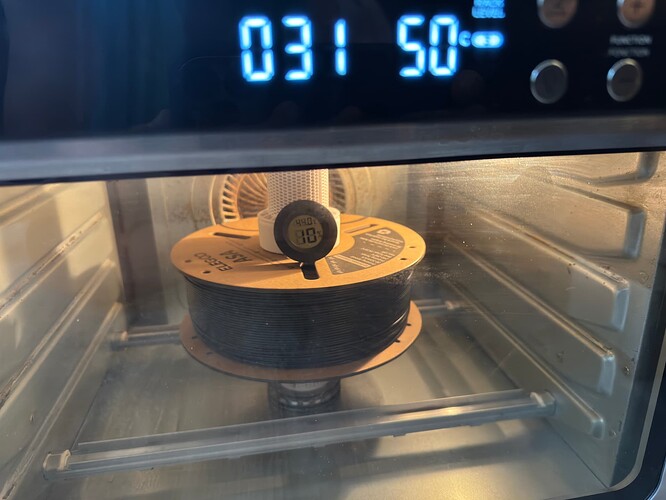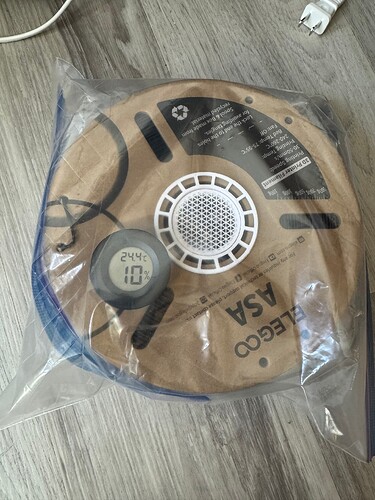Thanks for the link ![]()
I’ve had my s4 for a few months and it’s a good workhorse, it will melt pla spools ![]() .
.
I use it with abs and pa mainly and find it works well getting the heat through the coils. The noise isn’t dramatic as it’s made out, especially if you print in the same vicinity there really is no issue. I’ve come from an old Solvol 2-slot and an Amazon food dehydrator, it blows them both away and I feel the price is justified.
I’m home, chores done, sitting comfortably so I’ll be needed soon. I should get uncomfortable so I have more time…
Anyway, the S4. The biggest issue most have is that it only goes to 70. Doesn’t really bother me as it dries ABS and ASA just fine, just takes a bit longer on the PA6. The thermometer used is off, but I don’t know how much yet. I’ve been lazy and happy that it works well enough to keep PETG-HF flowing as well as my ABS dry.
It’s not loud, I asked my wife. I like it because I can store TPU or and CF filled filament and run it directly to the printer without much effort. I can also dry all the dessicant from the AMS in it with a tray at one time, evenly.
It’s big though. Make sure you have room for it. There are a few prints that allow it raised so there’s some storage under it.
Overall I’d recommend it if percision isn’t your goal. It will dry 4 spools and keep them dry as long as you want. You can set it to maintain, or to just dry and turn off. Setting a timer isn’t a big deal, goes up to 99 hours for drying, not that you’ll need that.
Oh, and it WILL warp a PLA spool.
I don’t have the space and use the printer at the moment. But when that changes, I will definitely get a food dehydrator, more specific, the Graef DA 2042. I think at a similar price point, it outperforms most dedicated dryers in most respects. It goes to 80°C, has very even temperature distribution, heats up quickly thanks to 300W, is isolated, releases moisture and fits two spools. The only drawback I can find is that it is not possible to directly print from it.
I really don’t see why I should accept drawbacks in almost every respect at the same price by going with a dehydrator
I got the hint in another 3d printing forum and think it is a great alternative.
There has been no evidence that a food dehydrator performs better than a purpose-built filament drier. However, two things are certain, yu can’t spool live from a food dehydrator and they are very space inefficient. But hey, in between filament drying session, one can always make some beef jerky. ![]()
True, I don’t have evidence. But I think that they are the much more mature products. And actually the requirements for drying food are not that far from drying filament: you want equal temperature, good airflow and moisture must be able to escape. energy efficiency and fast heatup are bonus features. Of course you want fine temperature control and 24h timer.
Regarding better drying: I think 80°C makes quite a difference for those engineering filaments that really need it. And homogeneous temperature is one of the key problems of many filament dryers.
The dedicated dryers remind me of those vacuum bags: they have been around for ages for the kitchen. some guys discovered them for filament and now every printer manufacturer resells them. But they all picked the cheapest crappiest version they could get for rebranding. If you look at vacuum bags for food, there are so much better ones but noone knows them here because it doesn’t say “filament” or “3d printer” in the name.
The filament dryers seem to reinvent the wheel and make all the mistakes that food dehydrators have probably solved 20 or 30 years ago. At least that’s my impression.
If I look at Amazon for the Graef, every second review is for drying filament and people are happy without exception. Which filament dryer can compare to that?
And I wouldn’t underestimate the benefit of food chips ![]()
I’ve 3 spools I’ve printed. I use them once in a while, PLA only. The printed spools are ■■■■ overall. They tend to break and you MUST print in PETG or better material. Better results had with buying a few Bambu rolls of material on spools and reusing them
I stumbled upon this YouTube video that compares the Creality Pi and the Sunlu S2 and a much older model of a dual Eibos dryer. His testing methodology has some serious flaws. As an example, he speaks to the unevenness of heating but he doesn’t do any hard testing other than the cool IR camera which doesn’t address the faulty hygrometers. He also went through the trouble of weighing the desiccant before drying but failed to weigh it after. However, he still came to similar conclusions that I found to be true when I did my bake-off between Sunlu and Creality that I linked above.
Bambu Lab says on their website that their spools (made of ABS) are resistant to 70c so I have no idea what went wrong here
Hi a rookie here, just started in the hobby for less than a month.
did lot of research and jump into P1S with AMS pro 2
i was doing research for filament dryer as i already printed with PLA and PETG without any issues. but i want to start using ASA later on. read that it needs higher temp and also it has more issues regarding to moisture compare the PLA and PETG
doing research i came on a youtube video guy using his extra air fryer.
but i dont want to use my own cooking with drying filament in case of oil and grease.
so i was able to find a cheap used air fryer oven for $10 CAD specially it has dehydrate feature so it will run 30C-95C
i tested and temperature is constant and humidity kept dropping until 10% (put a gauge inside the oven set at less than 50C, dont want melt the gauge.
later i DIY the oven installed a microwave plate turning motor that i have laying around.
then i printed few spool desiccant containers, modified a little, add a bearing and now seems to work
i will post a new thread in the future.
Oh by the way it is a picture so you might not be able to tell but the spool is spining as i installed the microwave plate turning motor under the oven.
You seem smart enough, so I’ll add my opinion…
Be careful with cardboard spools, even a dryer will dry out & flake causing dust to get all over the filament.
Drying like you have it could make the spools warp download, this is why filament dryers have the spool standing up…also so you can print from them.
Myself, I would make the bottom as flat as possible & the same width of the spool…JMO
thanks for the tip!
i will be using this only for drying so nothing more than 50C. after i will put them into double ziploc bag with desiccants in the center of the spool.
this black ASA roll i got it last week, but the bag had a leak, no vacuum and noticed some condensation inside the bag.
i put it double ziploc bags with desiccants last week for few of days and
dropped from 42% moisture to 38% very slow.
after i run this test with the air fryer oven for 60 min spinning last.
i put into bag again with desiccants in the center last night.
today wow 10% and holding.
i would be changing the center with a larger flat area for support. and i guess i should flip it on the second half of drying time.
now i am curious, if cardboard spools can dry out and flake, wont the vertical dryers would be even worse? specially the weight support when rolling are the cardboard spools right?
It can happen after a few days of printing…sorry I left that part out.
So far, I’ve only had the issue with my Space Pi…it’s the only dryer I own that has a fan, my other 2 don’t. I think the fan was the main cause.
It was a PLA spool. I no longer use that dryer with cardboard spools.


